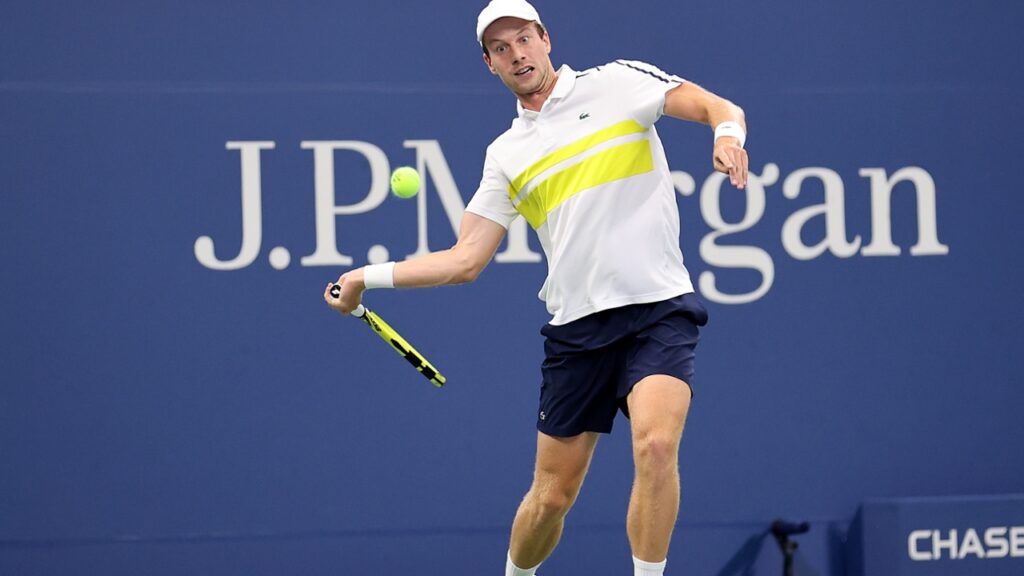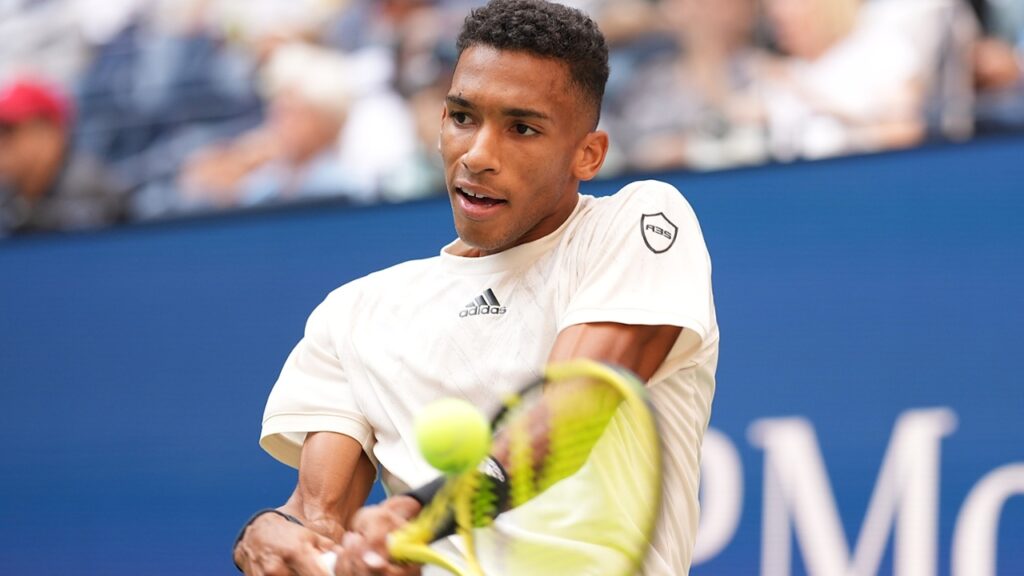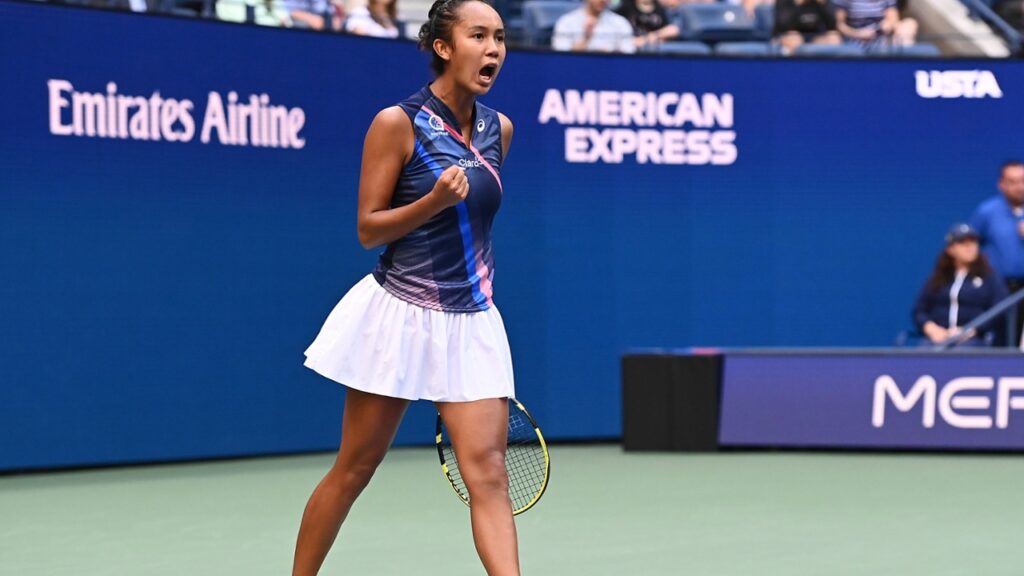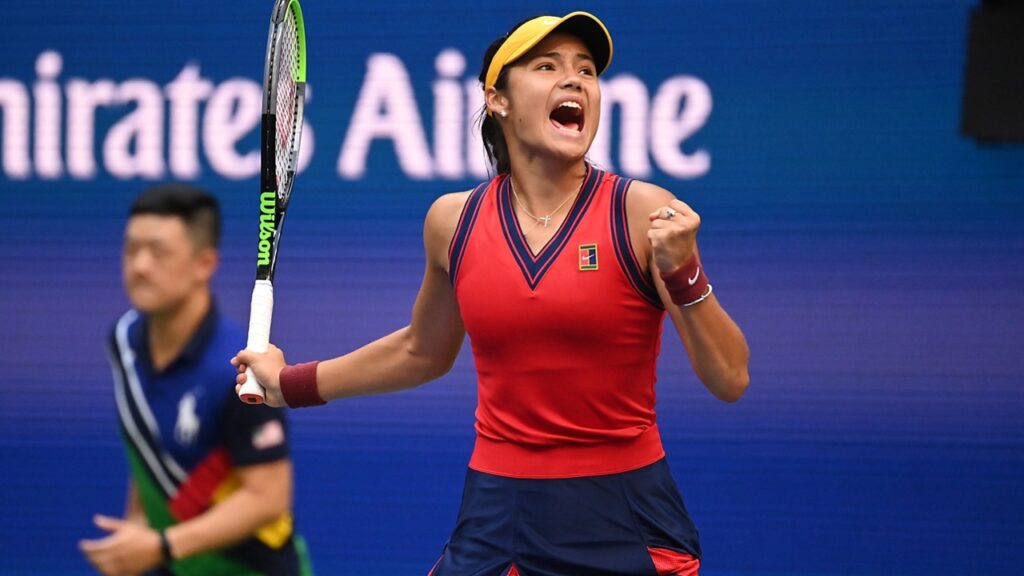The 2021 US Open was packed with wall to wall action from the start of qualifying to the championship clashes, as we witnessed dominant streaks, stunning upsets and pages upon pages of the tennis history books being written and rewritten before our eyes.
Along the way, we also saw several players who found a way to cut through the noise and capture the hearts and minds of tennis fans the world over. This year’s US Open was full of feel-good stories, from the qualifiers who beat the odds to the players who have been knocking on the door—and finally burst through on the sport’s biggest stage.
As we reflect on a historic fortnight in New York CIty, USOpen.org looks back at eight of this year’s biggest breakthroughs

Jenson Brooksby – Round 4 (l. to Novak Djokovic)
American tennis has a bright future ahead. After starting the year outside the Top 300, 20-year-old Jenson Brooksby has spent the summer turning heads and reaching new heights as he navigated the transition from Challengers to the pro tour.
Wildcard Brooksby made good on his opportunity, recording the best Grand Slam result of his career to reach the fourth round. Along the way, he defeated countryman Taylor Fritz, and stunned Australian Open semifinalist Aslan Karatsev, the No. 21 seed, in five sets. He bowed out in the fourth round to world No. 1 Novak Djokovic, but left the USTA Billie Jean King National Tennis Center with a newfound self-belief.
“It’s definitely all positive things to take away,” Brooksby said. “I learned my game. I’m feeling really confident in my game. I believe I can compete with anybody.”

Carlos Alcaraz – Quarterfinals (l. to Felix Auger-Aliassime, ret.)
Spain’s Carlos Alcaraz made sure his US Open debut was one to remember, continuing the upward trajectory that has seen him go from qualifying for his first Grand Slam main draws to knocking out the biggest names in the sport.
The 18-year-old became the youngest US Open quarterfinalist in the Open Era after upsetting No. 26 seed Cameron Norrie in the first round, and then going on to stun world No. 3 Stefanos Tsitsipas in a 6-3, 4-6, 7-6(2), 0-6, 7-6(5) thriller.
“I have no words to explain how I [am] feeling right now,” Alcaraz grinned after his third-round win. “I just don’t know what happened out there in the court. I can’t believe that I beat Stefanos Tsitsipas in an epic match. For me it’s a dream come true.”
Along the way, we also saw several players who found a way to cut through the noise and capture the hearts and minds of tennis fans the world over. This year’s US Open was full of feel-good stories, from the qualifiers who beat the odds to the players who have been knocking on the door—and finally burst through on the sport’s biggest stage.
As we reflect on a historic fortnight in New York CIty, USOpen.org looks back at eight of this year’s biggest breakthroughs
American tennis has a bright future ahead. After starting the year outside the Top 300, 20-year-old Jenson Brooksby has spent the summer turning heads and reaching new heights as he navigated the transition from Challengers to the pro tour.
Wildcard Brooksby made good on his opportunity, recording the best Grand Slam result of his career to reach the fourth round. Along the way, he defeated countryman Taylor Fritz, and stunned Australian Open semifinalist Aslan Karatsev, the No. 21 seed, in five sets. He bowed out in the fourth round to world No. 1 Novak Djokovic, but left the USTA Billie Jean King National Tennis Center with a newfound self-belief.
“It’s definitely all positive things to take away,” Brooksby said. “I learned my game. I’m feeling really confident in my game. I believe I can compete with anybody.”
Spain’s Carlos Alcaraz made sure his US Open debut was one to remember, continuing the upward trajectory that has seen him go from qualifying for his first Grand Slam main draws to knocking out the biggest names in the sport.
The 18-year-old became the youngest US Open quarterfinalist in the Open Era after upsetting No. 26 seed Cameron Norrie in the first round, and then going on to stun world No. 3 Stefanos Tsitsipas in a 6-3, 4-6, 7-6(2), 0-6, 7-6(5) thriller.
“I have no words to explain how I [am] feeling right now,” Alcaraz grinned after his third-round win. “I just don’t know what happened out there in the court. I can’t believe that I beat Stefanos Tsitsipas in an epic match. For me it’s a dream come true.”

Barbora Krejcikova – Quarterfinals (l. to Aryna Sabalenka)
For a Grand Slam champion to reach the US Open quarterfinals wouldn’t normally be considered a ‘breakthrough’, but that’s just the kind of year that Barbora Krejcikova has been having.
The 25-year-old Czech had already lifted two Grand Slam trophies and reached the world No.1 ranking in doubles. But in singles, she had yet to make her mark on court—until storming to the French Open title in June. When she arrived in New York, she didn’t have any singles wins to her name—in fact, she had never even qualified for the main draw.
But all of that changed this fortnight, as Krejcikova continued her singles renaissance with her second Grand Slam quarterfinal appearance. Along the way, she toppled former No. 1 and two-time Grand Slam winner Garbiñe Muguruza in straight sets.
“I really enjoyed it out there. I really loved the crowd,” Krejcikova reflected. “I didn’t know that the situation’s going to be like this: that I’m going to be sitting here, be a Top 10 player, have a chance to be in one of the main [interview] rooms. Everything is really, really positive.”
The 25-year-old Czech had already lifted two Grand Slam trophies and reached the world No.1 ranking in doubles. But in singles, she had yet to make her mark on court—until storming to the French Open title in June. When she arrived in New York, she didn’t have any singles wins to her name—in fact, she had never even qualified for the main draw.
But all of that changed this fortnight, as Krejcikova continued her singles renaissance with her second Grand Slam quarterfinal appearance. Along the way, she toppled former No. 1 and two-time Grand Slam winner Garbiñe Muguruza in straight sets.
“I really enjoyed it out there. I really loved the crowd,” Krejcikova reflected. “I didn’t know that the situation’s going to be like this: that I’m going to be sitting here, be a Top 10 player, have a chance to be in one of the main [interview] rooms. Everything is really, really positive.”

Botic Van De Zandschulp – Quarterfinals (l. to Daniil Medvedev)
Before this fortnight, Botic Van De Zandschulp had never stepped foot in New York City or even travelled to the United States. But after a head-turning three weeks in Flushing Meadows, van de Zandschulp made sure tennis fans won’t soon forget his name—although they might still struggle on the pronunciation.
The No.117-ranked Dutchman had to do things the hard way, going through three rounds of qualifying to reach the main draw, where he came back from two-sets-to-love in the first round against Carlos Taberner. He scored a major upset over No. 11 seed Diego Schwartzman in four sets to become the first male qualifier to reach the quarterfinals since Gilles Müller in 2008 and Nicolas Escudé in 1999.
“I think what I have done for me, it’s amazing that I beat No. 11 here, especially in a match like this. For me, it was the first time in the big stadium,” van de Zandschulp reflected. “I knew that I could beat players who are ranked 20 or 10 in the world. But I didn’t do it like this often, this consistently. That’s new for me.”
The No.117-ranked Dutchman had to do things the hard way, going through three rounds of qualifying to reach the main draw, where he came back from two-sets-to-love in the first round against Carlos Taberner. He scored a major upset over No. 11 seed Diego Schwartzman in four sets to become the first male qualifier to reach the quarterfinals since Gilles Müller in 2008 and Nicolas Escudé in 1999.
“I think what I have done for me, it’s amazing that I beat No. 11 here, especially in a match like this. For me, it was the first time in the big stadium,” van de Zandschulp reflected. “I knew that I could beat players who are ranked 20 or 10 in the world. But I didn’t do it like this often, this consistently. That’s new for me.”

Felix Auger-Aliassime – Semifinals (l. to Daniil Medvedev)
Canada had a lot of talent to cheer for this fortnight, including a long-awaited breakthrough from Felix Auger-Aliassime. The youngster from Montreal has been challenging the best in the world for such a long time that it’s easy to forget that he’s just 21 years old. But at a US Open tournament defined by the youth, Auger-Aliassime put together the best Grand Slam run of his career to reach the semifinals for the first time.
Along the way, he had to go the distance in a five-set epic against No. 18 seed Roberto Bautista Agut, before rallying from a set down to oust good friend Frances Tiafoe in front of his home crowd. He became the first Canadian men’s singles semi-finalist in US Open history (since 1881) in the process.
“I’m more and more confident I can be at this stage more often,” Auger-Aliassime said. “I’m just trying to focus on what I have to do to improve and to put myself in these situations. But I have always had the belief, with the ups and downs, that I could and I deserved to be in the position I’m in today.”
Along the way, he had to go the distance in a five-set epic against No. 18 seed Roberto Bautista Agut, before rallying from a set down to oust good friend Frances Tiafoe in front of his home crowd. He became the first Canadian men’s singles semi-finalist in US Open history (since 1881) in the process.
“I’m more and more confident I can be at this stage more often,” Auger-Aliassime said. “I’m just trying to focus on what I have to do to improve and to put myself in these situations. But I have always had the belief, with the ups and downs, that I could and I deserved to be in the position I’m in today.”

Maria Sakkari – Semifinals (l. to Emma Raducanu)
Last year, Greece’s Maria Sakkari announced her arrival at the USTA Billie Jean King National Tennis Center with a win over Serena Williams during the relocated Western & Southern Open. But it would take until 2021 for everything to finally come together—and Sakkari has never looked back.
After becoming the first Greek woman to reach the last four at a Grand Slam at Roland Garros in June, Sakkari repeated the feat again at the US Open. To achieve this, she had to topple two-time Grand Slam champion Petra Kvitova, 2019 champion Bianca Andreescu, and former world No. 1 Karolina Pliskova—and she did it all at the expense of just one set.
“I want to dedicate this win to Greece because we struggled a lot last month with some fire damages,” Sakkari said after her quarterfinal win over Pliskova. “Winning for Greece, making Greek people proud and happy, especially in difficult times, it makes me even more happy because you know how much I love my country.”
After becoming the first Greek woman to reach the last four at a Grand Slam at Roland Garros in June, Sakkari repeated the feat again at the US Open. To achieve this, she had to topple two-time Grand Slam champion Petra Kvitova, 2019 champion Bianca Andreescu, and former world No. 1 Karolina Pliskova—and she did it all at the expense of just one set.
“I want to dedicate this win to Greece because we struggled a lot last month with some fire damages,” Sakkari said after her quarterfinal win over Pliskova. “Winning for Greece, making Greek people proud and happy, especially in difficult times, it makes me even more happy because you know how much I love my country.”

Leylah Fernandez – Final (l. to Emma Raducanu)
Few people had Leylah Fernandez on their US Open winning bracket before the start of the tournament. By the time she had knocked out defending champion and No. 3 seed Naomi Osaka in the third round, coming back from a set down in the process, everyone knew we were in for something special.
The Canadian—who turned 19 during the fortnight—played like a veteran as she ousted two more Top 5 players, No. 5 Elina Svitolina and No. 2 Aryna Sabalenka, and rallied against former champion Angelique Kerber as well. She became the second Canadian teen in three years to reach the US Open final.
But even more than her wins, it’s been her complete self-confidence that has captured the admiration of tennis fans the world over.
“I’m very happy with myself, with the way I competed, and the play I played, the way I acted on court the past two weeks,” Fernandez said after the final. “I’ve improved a lot not only tennis-wise but emotionally and mentally.”
The Canadian—who turned 19 during the fortnight—played like a veteran as she ousted two more Top 5 players, No. 5 Elina Svitolina and No. 2 Aryna Sabalenka, and rallied against former champion Angelique Kerber as well. She became the second Canadian teen in three years to reach the US Open final.
But even more than her wins, it’s been her complete self-confidence that has captured the admiration of tennis fans the world over.
“I’m very happy with myself, with the way I competed, and the play I played, the way I acted on court the past two weeks,” Fernandez said after the final. “I’ve improved a lot not only tennis-wise but emotionally and mentally.”

[Q] Emma Raducanu – Champion (d. Leylah Fernandez)
Without a doubt, the biggest breakthrough of all belonged to 18-year-old qualifier Emma Raducanu, the 2021 US Open champion. Just let that sentence sink in. Read it again: 18-year-old qualifier Emma Raducanu, the 2021 US Open champion.
In one of the most improbable Cinderella stories in all of tennis, the young Brit—who had never played a match at the US Open—not only won the tournament on her debut, but she did so without dropping a set. In fact, she didn’t lose more than five games in a set, and even then it was only once in the tournament: during the second round of qualifying. Along the way, she defeated Olympic gold medalist Belinda Bencic and No. 17 seed Sakkari before edging past Fernandez in the final.
“I just can’t believe it. A shock. Crazy. All of the above,” Raducanu said. “I always had dreams of playing in Grand Slams, but I just didn’t know when they would come. To come this early, at this point in my career… I’ve only really been on tour for a month, two months since Wimbledon. It’s pretty crazy to me.”

